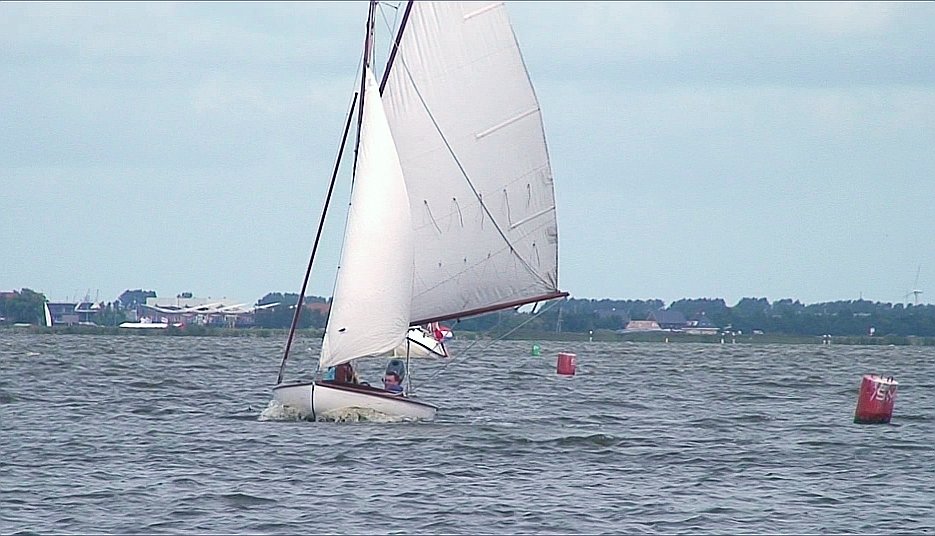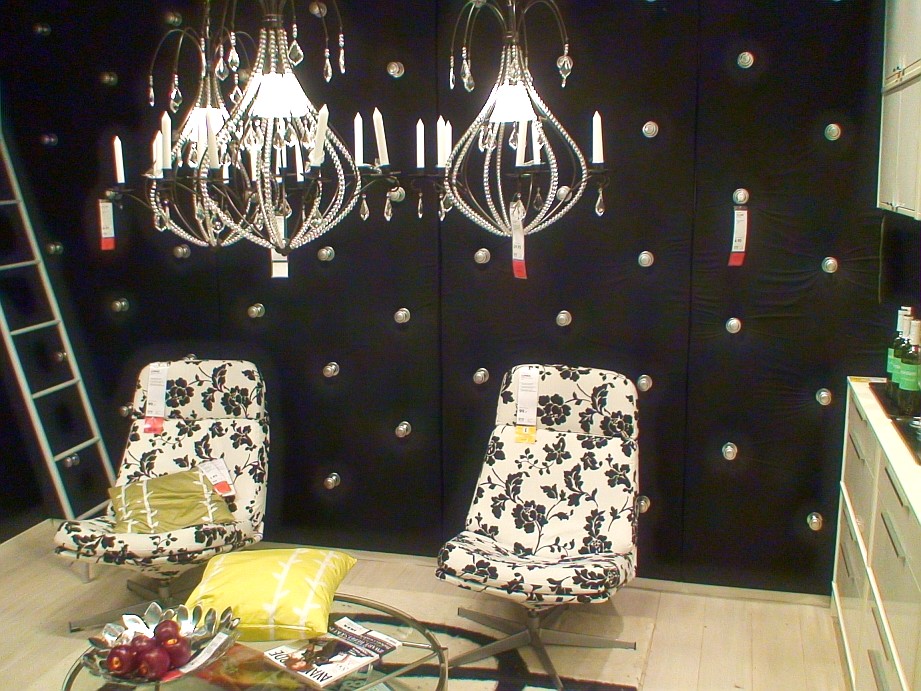Theo Verelst Local Diary Page 40
I've ditched the usual header for the
moment, I think it doesn't help much anyhow.
This page is copyrighted by me, and may be read and transfered by any
means only as a whole and including the references to me. I
guess thats normal.
Tue Sep 18 17:27, 2007
Don´t forget to look at the last 2 diary pages, too, which were
finished fairly recently, with a lot of interesting materials on them,
and don´t forget to get in touch if you want to sponsor a Red
Digital Cinema 4k cinematographics camera (´only´ 17k$ but
as you know I have no money) or maybe even if you have an interesting
HD film subject within say western europe, or that and a ticket...
From http://www.theover.org/cgi-bin/fortune.tcl
:
Fortune from Sun Sep 30 22:01:35 CEST
2007:
Life would be so much easier if we could just look at the source code.
-- Dave Olson
Sure. I guess that would require you to be God or so.
Big Audio?
I got these pictures from here
(roller-disco somewhere in Brooklyn),I hope my quotes are fair use and
appreciated, for a reason: they illustrate a point I'd want to make
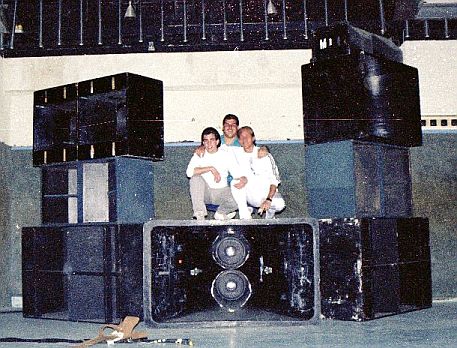
"The Leviathan is a huge (about 6
feet long) 2-piece fiberglass bass horn speaker driven by two 15"
woofers. It could throw bass long distances."
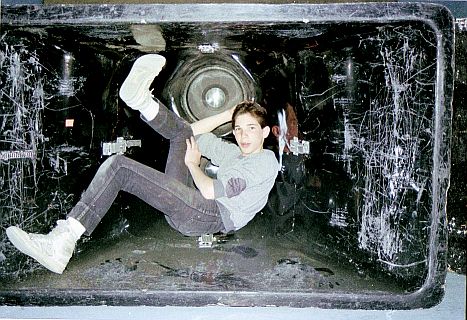
Funny, of course, but also there is a speaker system design point: it
is hard to direct waves of low frequency tones and noises.
More importantly like in the upper picture: creating low frequency
waves which are good and exciting takes biiiiiigggg speakers!
That´s a physical law, large waves can´t be created
much with small moving parts. My audio system is based on the
assumption that speakers can be big enough to reproduce low frequencies
well, without having to be as extreme as above, but still my sub woofer
(for under 40 Herz) is a 15 inch one, too. Physics, madames et
messieurs. The resistance of much smaller cones for real low
frequencies is so tiny that little power is put into moving airwaves,
and the only quasi remedy is to suggest low frequencies by overtones
and modulation effects, which is boring and the trick doesn´t
stand the test of time. Many speakers in a plane can work, too, for
instance the good ol´ bose speakers implemented that principle,
but it wasn´t for nothing that the famous ones were amoung the
first speaker system designs which were designed with the help of
computer simulations.
In highschool I was used to listening to a for the time pretty big
disco sound system of no particular audio quality level, but certainly
really loud and loads of real bass and good music. What a hell people
must be in nowadays when stuck with the new age mess and annoying sound
systems they got. Not good for musical education, too, in my opinion
all those fake effects don´t measure up to real speakers doing
their well known jobs and normal distortion things.
PA systems are getting digital, cheaper I guess, more powerfull per
kilogram and possibly more complicated, but I don´t think in
general decades of progress have yielded great sounding sound systems
in general much, just like in the studio monitors are probably fine on
average, but really, compared to the good stuff in the 70´s
nothing is much fine and great I think. So the new age kicks in to take
it all over ? Euhm, I think rather they tried and failed!
Well, my system does sound great, and good on just about any material
from classical to rock, from folk to funk, from tv watching to studio
monitoring, and certainly it has the power and the gloriousness to
sound really great for watching films, too.
So given the success of my approach in my daily practice why not think
about bigger PA systems, too, I´m a graduated engineer for
christs´ sake, so it makes sense to after good american habit try
to think BIG, doesn´t it.
My system when I resolder some wires or patch the electronics a bit can
produce at about 600 watts of RMS power (300 sub, 200 main, 50 of mid
high section, and at least 2x30 for the rear bi-amped monitors), though
honestly the supplies together can officially according to specs
produce a fully continuous power of a respectable kilowatt (400 main,
230 mid high, 300 sub, 120 biamped mon.), which is of course almost an
insane amount of power for in a living room, and as I said the
electronics currently are hard limited to about half the maximum
voltage I think, and settings of the end amplifiers are also much lower
than maximal, and the normal volume controls, too.
Yet it is good the system has the power, even if it were only for
current peaks and general stability, but of course also for another use
than home cinema or studio. In a hall on stage, the 100 Watt per main
channel plus more power for under 40Hz is fine for small places when
things are under control, but even a not huge partyband will easily
hire a kilowatt system for PA at a gig, then mys systems power can only
work when it is used well. It sounds exquisit in that case, but it
doesn´t have what it takes to hard-rock the back row of a hall
because that simply requires more power.
I can in such case steep to the level of using tricks like adding well
known types of distortion to the signal so that the percieved
loudness is higher, and I make use of the efficiencies of the speakers
for certain effects, so that a lot of noise can be produced. That can
be cool, because than the system can produce the sounds of varying
types of PA systems by mimicing them, and probably a small hall would
then have to face quite siginificant sound pressure levels without
having to go crazy with reflected sound.
Great, but just the last bit to add the rock kick to even a not so big
hall, you need more power I think, 110 dB at the back row at the height
of a concert requires more watts for sure. So I could make a bigger
system for live use of that kind (a lecture at the stamp collectors
meeting is no problem, and playing nay music there would easily make
people shout soooofffttteer when the volume is opened... and of course
the quality would be absolutely great) with the power it takes to rock
a bit bigger place, and preferably also of superb quality, without many
compromises.
It sounds almost unpopular to suggest such a thing... Well, if somebody
else would do that and not bother me, I´d think it is a great
idea, especially when it is made to work. Well, in my case the actual
power and sound pressure of the actually working and usable system (it
is often on 10 hours a day and regularly 24/7 for years already) is
considerable already. Without setting it of into distorting crap or
wonderfull distorting gitar notes or so, it can easily be set louder
than required even at a loud disco party, not a problem at all, even in
a small hall instead of a big living room. And I mean you can put on
AC/DC at such a volume that you wouldn´t hear your neighbour much
unless he/she would shout in your ear, just like I was used to at
school parties, and then it sounds pristine, which is a different
loudness experience.
The easiest way to get more power of such quality is repetition:
I´d just built two more similar systems, or 5 or 10! And then a
stack of speakers or so at each side of the podium, and 8 amp sets and
wires, and blow it all away! Yep, that´s appealing. Maybe 20 for
even more analog amplified and seperation filtered fun in a big space,
and then my analog computer controlled (ethernet) mixer so we have no
group delay or sample reconstruction issues for one loud night every
now and then.
Well, a Qsc for instance (which have great movies on their website,
which work cool on my home theater, too) make also very loud PA
systems, and system control units to drive them and keep all the
signals right:
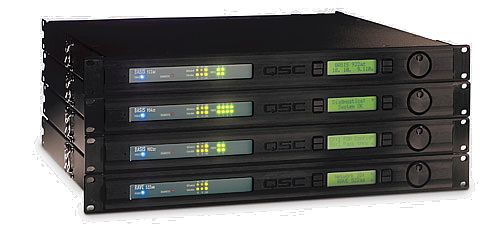
QSControl.net from QSC
Just like I read about a big stadion with 100s of kilowatts of audio
power (!) which used these machines to control to power:
see aphex.com

What is this all ? For big audio systems put at loud volumes, several
problems must be solved somehow, first a big powerfull system might get
too loud sounding when something goes wrong, like somebody shifting a
fader too far on the mixer, or when a microphone is displaced and
starts a feedback sound that could on a big system cause sound pressure
levels i the pain area of the human hearing.
Second, speakers and to a lesser extend amplifiers can be blown up, for
instance when a microphone is dropped, or a digtal glitch occurs, in
the first case the whole speaker system could get a impulse which could
seriously damage it, depending on the amplifier power rating and the
used way of achieving "cruise power" with the system, the impulse could
damage woofers, midrange speakers and tweeters, or even all, and when
no multiamplification is used, and the power of the amp is not low
compared to the speaker rating, even all speakers could blow up, and
when the high level signal remains a while, one part of the speaker
blowing up could set the rest up to blow even faster. The digital
impulses with modern fast amplifiers are mostly damaging to good
quality tweeters, they can get relatively much power to handle in s
short time, they have relatively fragile buildup for large impulses,
and modern amlifiers can give high power bursts of high frequencies. PA
tweeters are more rugged, but usually are the first to go anyway.
Third, during a show or performance it is usually impossible to work
without some form of compression or especially limiting taking place so
that also normal program material like a sudden loud voice, a hard
played snare drum, a guitar solo would cause too much power to be
produced, either for the system, or for the audience, and are
electronically limited by some form of fast volume control circuit
setting in at the maximum desired power.
Less optimistically, when the PA person is not well trained and aware
of the performance it is lkely that the performers and the PA person
are actually relying on all kinds of explicit or implicit limiting and
compression taking place, and with a big pro system that usually would
have to be explicit electronics. It could even be the whole PA is
constantly compressing and limiting and everybody on stage is only
trying to get a big part of the spectrum all the time, which is ugly
and unpressional. The limiting in the case of a potent PA, which is
ample power for the amlification job is probably desired to be
frequency dependent, adjusted to the speaker systems and setup at hand,
and possibly transient dependent, so that the customers can get close
the highest loudness levels easily, without passing into the danger
zone.
"I can hear mirads of bad DSP tricks coming up this allay..." So can I.
Well, the idea of a loudness curve-aware limiting system is fine in
itself, and compression/limiting for live source is desirable, and for
a full range (preferably 20Hz-20kHz) PA system it is then needed
to think good, and imperative it has quite some power, and depending on
how many seperately amplified frequency bands there are, precautions
must be made to possibly limit frequency bands seperately on purpose.
For a good amplifier / speaker system it is normal that the nomial
rated power is somewhat more than the normally required power, so that
clipping of other types of limatation related distortion are kept away
in normal practice. That however will make a system with a lot of power
reserve in practice, depending on the the multiamping setup, which must
therefore be electronically safeguarded against abuse and error.
That is where the above machines come in: they provide signal routing,
multi amping filtering, and multigroup limiting (possibly compression)
so that the amplifiers for the different types of connected speakers,
and possibly for the different places speakers are set up can be driven
and limited and filtered properly.
Got any additional angles, theover? Well, my main angle in general for
years has been high quality, which is in my opinion supposed to be all
over HiFi type of high quality: full range, accurately straight (if
possible), low harmonic distortion, low transient distortion, low
intermodulation distortion, no group delay errors (VERY annoying in all
kinds of DSP), no resonances (short, well defined, close to no
character waterfall), and also all this preferably in a LINEAR way, so
that everything works over a range of vilumes, in my case from
whispersoft (for night time television) to extremely loud (over 110 dB
and a bit more).
Seldom all these demands are reasonably speaking met, and of course in
my current systems I attempt to engineer as in following this sort of
holy grail. A lot of listening and some (I'm currently poor, remember,
I don't have much measuremnt facility) testing with measurements, and a
lot of (official) part specification datasheets tell me that is working
great, though there is always room for improvement!
I can almost hear a lot of people think: that is "b*llsh*t", or "we
cannot work that way!", or "the band doesn't ask for that", or even:
live amplification is not a linear system! Well, ok, let professor me
explain in short what the idea is. Sure people want non-linear
amplifiers, liek guitar cabinet amplifiers, but that is stricktly
speaking an effect, not merely a amplification system only. ALso, they
want "humps and bumps" to play with, like bass reflex ports, more
subtle amplifier distortions, resonances, microphone near-feedback
effects, but these are all not part of a good PA system. The guitars
can be picked up from the guotarists favorite amp, the humps and bumps
can be made by the mocrophoe (popular way) and of course by additional
effects in the microphone channels of the mixer, and the playing with
the bass reflex by the whol band together is very unpopular with pro
audio engineers and good listeners because it is so extremely boring
after 3 minutes...
Effects liek reverb, equalisation (after the taste of the performer)
even exiters (adding subtle distortion products to enhance the sound of
the spectrum) are cool of course, and singers may prefer heavy
distortions or old microphone effect to added. But when the PA
amplifier/speaker system is straight, all roads are open and the
desired sound can be "made" like in the studio, inlcuding compression
as desired, and tailored to the system and the space being played in.
That of course also includes possible feedback killers. At the end of
the signal chain the various output signals go to the amplifier
battery, and need to be limited and filtered, and maybe processed for
the speakers/amps at hand, and then the amps feed the various speaker
sub systems, and are adjusted to at least limit when the some preset
power (or signal) level is reached, as a sure limit to the maximum
sound level when the PA engineer is not paying attention or too slow to
respond. Saves ears and speakers.
Complicated machines like above may also want to compute actual power
or sound level with a given amp and speaker system, because signal
levels relate to output power in a not very neutral frequency and
signal dependent way. In principle speaker current and voltage could be
measured, or a course characteristic frequency dependence of the used
speakers could be programmed in.
Either with the digital or the analog systems from above, the
distortion figures for when the signal passes through unlimited are 10
times too high for my purposes or for my aims, so that is my interest
at the moment. Of course, there are many setup tricks possible and
people may find it strange to want less then a hundredst of a percent
distortion from some signal units in the path when guitar sounds being
fed in distort harmonically extremely and while speakers probably add
percents or tens of percents of distortion!
Unless you make the whole sytem from microphone to speaker as linear as
possible liek I am trying to do in my setup, then I am sure (you can
come and listen) that because of the kinds of distortion being added
also in signal processing blocks (which us usually fairly low compared
to rawdy PA systems), those distortons add up to a far less comfortable
listening experience. That is because that distortion is always there,
is seldom annihilated by effects in speakers, and is basically annoying
because human hearing is fairly sensitive to it.
The good ol´ US of A
I saw a larger version of this photo on philly.com or so, as a
comparison about how things look, on pictures, anyway.
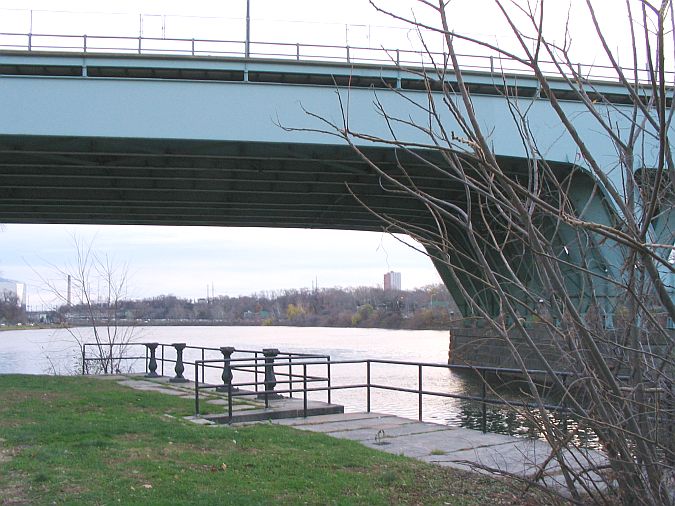
Arendsoog
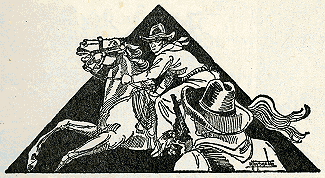
I used to read books from the public library as a kid by the
dozen (reading indeed, not browsing), one of my favorites was Eagleseye
a as it appears dutch series of story books about a ranger in Arizona.
I didn´t check a library if they stil have it, but the internet
is resourcefull as ever a very short example quote from this
book:
I. In Mining-Valley
Een mijndorp, zoals er in de dagen
van de goudkoorts vele waren. Het voornaamste punt van samenkomst was
de herberg of ‘bar’. Ofschoon het daar gewoonlijk niet al te kalm
toeging, scheen er, te oordelen naar de grote luidruchtigheid der
bezoekers nu toch iets bijzonders aan de hand te wezen.
‘En ik zeg je, dat ik voor den duivel
nog niet bang ben, laat staan voor dien Arendsoog van jullie!’
Het was een grote, fors gebouwde
kerel, die dit zei. Zijn ruw behaard gezicht drukte minachting uit,
minachting niet alleen voor Arendsoog, zoals hij daareven zei, maar ook
voor alle mogelijke menselijke en goddelijke wetten, als die in zijn
kraam niet te pas kwamen. Hij sloeg met de vuist op de toonbank,
waartegen hij leunde, en zag uitdagend in het rond.
Even viel een stilte op zijn woorden.
De anderen keken elkaar aan, schuw, bevreesd.
‘Als ik jou was, vreemdeling,’ zei er
toen een, ‘dan zou ik niet zo hard spreken. De muren hebben hier oren.’
‘Kom, kom!’ was het schamperlachende
antwoord.
In English (translated by me):
"A
mining village, like there were many in the days of the goldfever. The
inn or the bar were the most important gathering points. Although
things would usually not be all too easy going, judging by the big
commotion amounst the guests something special appeared to be at hand.
´And I tell you, that I am not
even affraid of the devil, let alone for that Eagleseye of yours!´
It was a big, heavily built guy who
had spoken. His raw bearded face expressed contempt, contempt not only
for Eagle Eye, like he just said, but also for all possible human and
divine laws when they wouldn´t agree with him. He hit the counter
he leaned against with his fist, and looked around challengingly.
A little silence followed his words.
The others looked at eachother, timid, affraid.
´If I were you,
stranger,´ a person said then, ´I wouldn´t speak so
loud. The walls have ears.´
´Is that so!´ was the
sneering answer."
See this
historic text link for the whole book, with some picture scans
(from 1935).
I remember the comments from a lot of people since I was a student
about the US, which wasn't very pretty, and that is not nice on
average. I guess the term policing the whole world was relatively nice
but it is of course so wrong that the whole world crates the mess that
than the us must lead or solve, and on top of that get called the most
polluding and imperialistic or ' the american mercinaries' or so,
considering where almost all he good things come from one needs to be a
well informed adult to keep track of right and wrong here.
Of course, the blues brothers get rejection and trouble in the US too,
and human beings should by nature all be considered sinners and
inclined to evil, but why must only americans listen to southside and
help the rest of the expanding world population getting access to all
the luxury created in the us?
More decompressed music ?
Well jeah, sure, luckily. I found out for the 4 or even 6 tracks to be
seperately decompressed I made use of the fact that I used another X
server then the one on the local machine, so that the pixel filling for
the VU meters was done remotely, or else I need to go root and also run
the Alsa (or OSS) audio at real time priority, or I´d get
failures, which sounds real nasty on the big audio system, especially
when it is set not so soft and has a lot of headroom because I control
the volume by the cinelerra sliders, that is in the digital domain.
When set to root priority with bit longer buffers, the decompressed
music sounds best on the Lexicon DA converter (which has become
cheaper, I read), and the decompression sounds probably more
consistent, though I was satisfied enough. I made more than a few more
songs decompressed en re-equalized, and some for the first time with
triggered decompression, like Baker street, by Gary Rafferty (world
famous of course int he 70s).
Chances of hearing loud music are good when I am trying out yet another
song, the big system sounds extremely good also at a bit more power
then 'normal', in fact it it quite up to playing disco with when called
for, and as many people know good and quality music sounds better at a
bit of volume. If their would be peak power meters in the speaker
output chains, there would considerable peak measurements when I'm
feeling like it, but then again the actual peak power available from the
system is far more than normally required (in the range of a kilowatt, which is not good for
some of the speakers). As it is set up there is a stringen power
limitationin through the preamp maximum voltage, and also the main
volume controls are never set to where they were when I did try the
system out on a fair some time ago, but the system is cool, it works
great at more modest power, and never I've had a problem, it even works
as TV amplification, and even at very low volumes, no problem.
Electric race cars
When I got away from university about a decade ago I thought about that
subject, and though it would be great to have fast electrical vehicle,
because that should be possible and is a sort of compensation for the
limited range. Fast electrical cars exist now, and even really fast,
like faster than a ferrary and a posche!
This is a nice one, the wrightspeed X1, costing about 150k dollar (I
have virtually none at the moment):

Here is is shown to actually and clearly out-accelerate the ferrari and
the not small porsche:
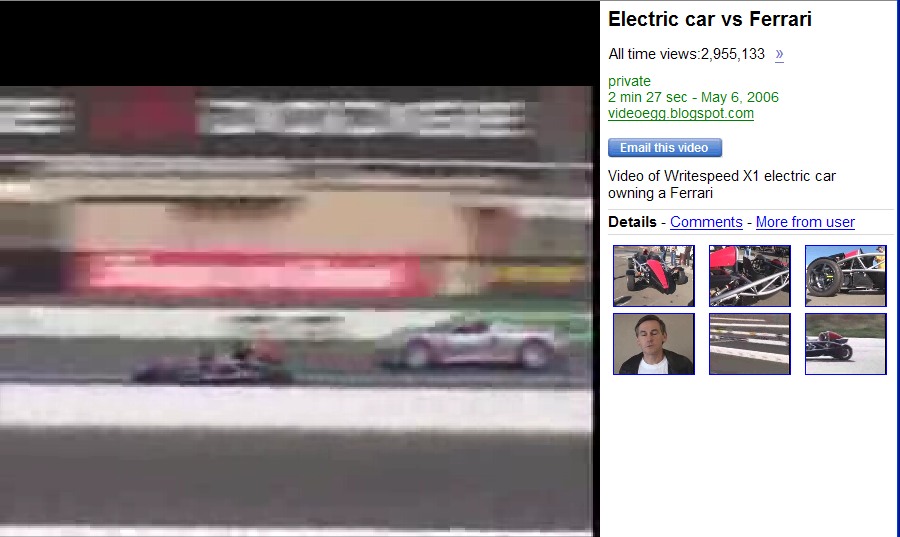
On video.google.com
there is race movie of the electric car
It would be great to drive such a machine, especially in CA.
From the surface it isn't clear how hard it is to make electrical
driving possible. Clearly one needs batteries or another power source,
like a well tuned medium power, fixed RPM motor in a hybrid, which need
to store a lot of energy, which trditional batteries wouldn't make very
practical for normal acceleration and driving power and a reasonable
range they would be very heavy.
It aappears that notebook LiIon rechargables are very usefll in this
respect, though even better power per weigth and volume is possible.
These are of course produced in volume which is usually good for the
price.
The weight of the batteries must be placed somewhere in a good place in
the car, and very big charger is needed to make enoug sense for a
serious electrical car to work in practice, one that can draw kilowatts
from the mains or better yet more than a few kilowatts from a
specialized outlet. Technically possible, but such high power charcher
which works good, effecient, safe, well behaved for the power grid,
interference free and keeps the batteries in good shape is far from
trivial.
Getting a controlled amount of power from the batteries to the motor of
the vehicle is also not easy, with similar considerations playing a
roll, the power converter to be used from many battery cells driving a
motor of a least a few tens of kilowatts is big electronics.
And of course the whole machinery needs to work and reliably so.
More mastering
In fact of some of the same studio (not mine) masters. In this case I
felt prompted because I downloaded and compiled and set up the JAMin
equalizer and multiband compressor program with jack on Fedora Linux,
which was a bit of work, but interesting. the program has a big, wide
control range 32 (!) band equalizer, and three band seperated
compressors, volume boost controland a limiter. In fact the equalizer
responds to a 1024 wide graph to compute the frequency respone from,
and it can show the spectrum in such a way, too:
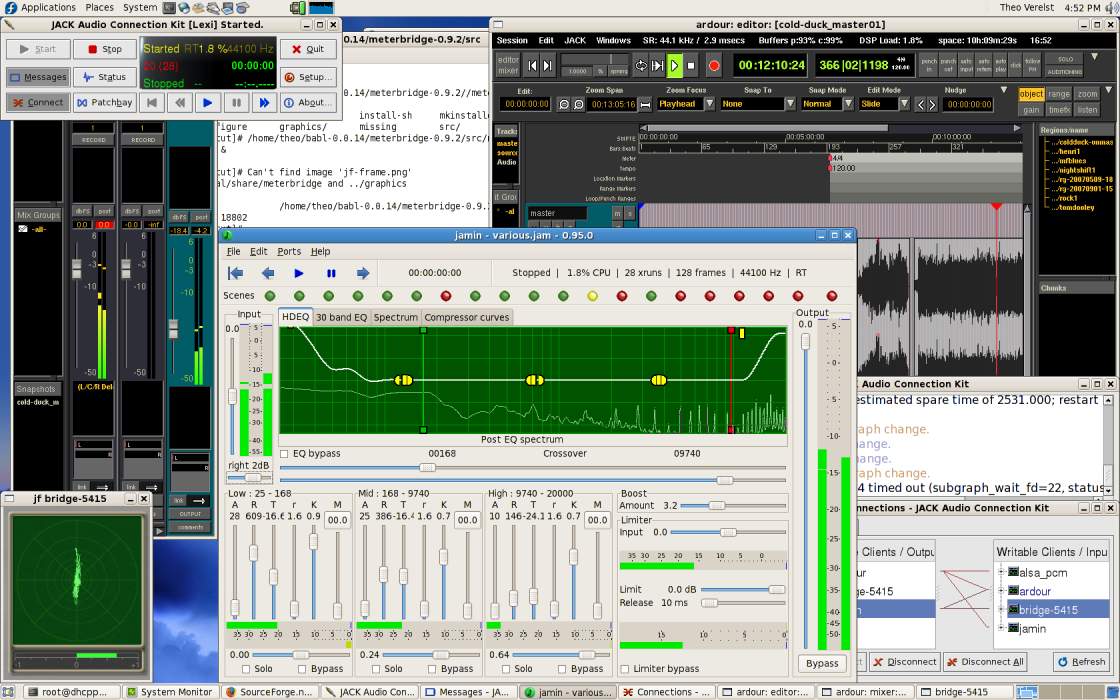
It can make use of a Fast Fourier Transform or an Infinite Impulse
Response filter to do its computations on the incoming audio, and it
uses JACK on Linux to connect up.
I'm not fond of ffts, and honestly I don't think the IIR filter
response is to write home about, but the program does allow strong and
variable equalisation and in spite of the limited range of the time
constant controls, the compressors do work and an actual master can be
made with it, though I dislike the idea that the signal sounds quite
noticably different when the program is switched from Bypass to feeding
a signal through the equalizer while it is set to flat.
I've used yamin on the tutorial example a bit like the tutorial with
the ardour audio multitrack program and have come up with this
result for the given example
(see ), mp3, 256Kb/s.
which sounds hip-ish and at least a bit more interesting then the
unprocessed version, which maybe isn't needed for the music, but why
not. An existing remastering project from a AAD studio master (which
had become ADD by my work with cubase some time ago) could certainly be
tweaked in major and interesting ways, but I must say I still don't
like the fft or the effect of it enough to want to use it on my own
materials.
It could be used though to estimate more bit accurate signals from for
instance 16 CD tracks, when used on the midrange, for isntance before
decompression, that could be interesting. I've made a mplayer version
which can connect to jack, so I can feed audio networks with internet
radio or CD tracks.
I looked for audio level meters on the web and found
´meterbridge´ which is a set of meters for VU, program
peak, bar VU and jellyfish (stereo analysis) which I downloaded,
compiled and installed on the Fedora 7/64 machine, they´re shown
in action on
the below screendump, as part of a connected audio programs setup:
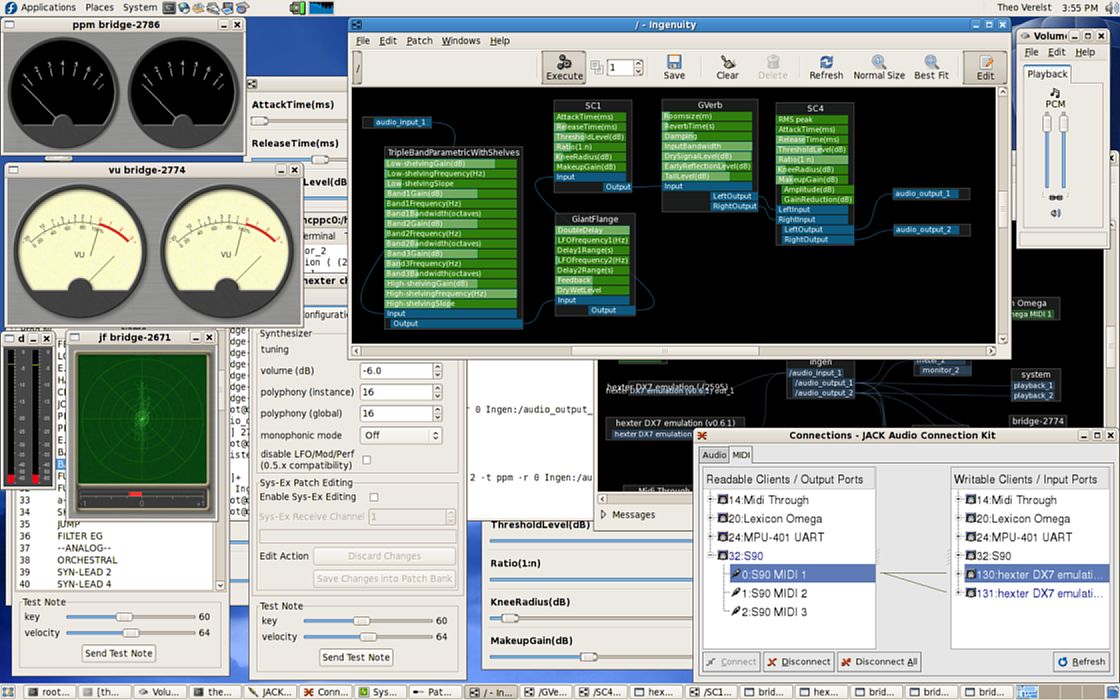
Example Screen with
meters, hexters, midi connections, patchage and ingenuity (click for
full size screendump image)
The meters work fine, although I wonder how much they exactly compute,
like peaks which would only be well measured when a sinc function based
reconstruction of the analog signal would be done. The jellyfish left
right correlation meter is fun, though probably a bit limited, though
it takes a lot of computation power, about a third of the athlon
3.3GHz/64 !
I liked to try some programs out together, so I made a big multiscreen
setup with some challenging programs, hexter (dx-7 FM synthesis
simulation), PureData graph based synthesis, ingenuity with various
processing blocks like reverbs and compression and equalisation and
mixing, and Rosegarden to record and playback audio and Midi. All the
following screen dumps from a big monitor (click for original sizes)
are from a running setup taking 4 Linux virtual screens which can be
clicked through to work with (little icons at the bottom right of the
screen):
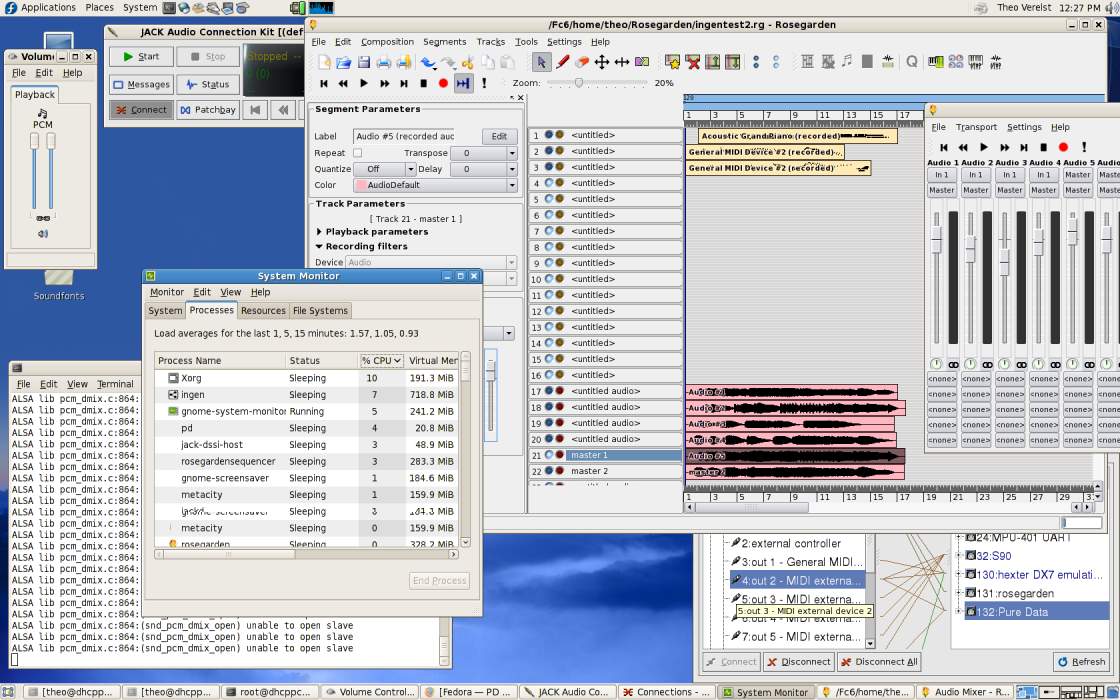
Screen 1 with Rosegarden and qjackctl

Screen 2 with patchage showing the ingen
constructed insert effect and connections
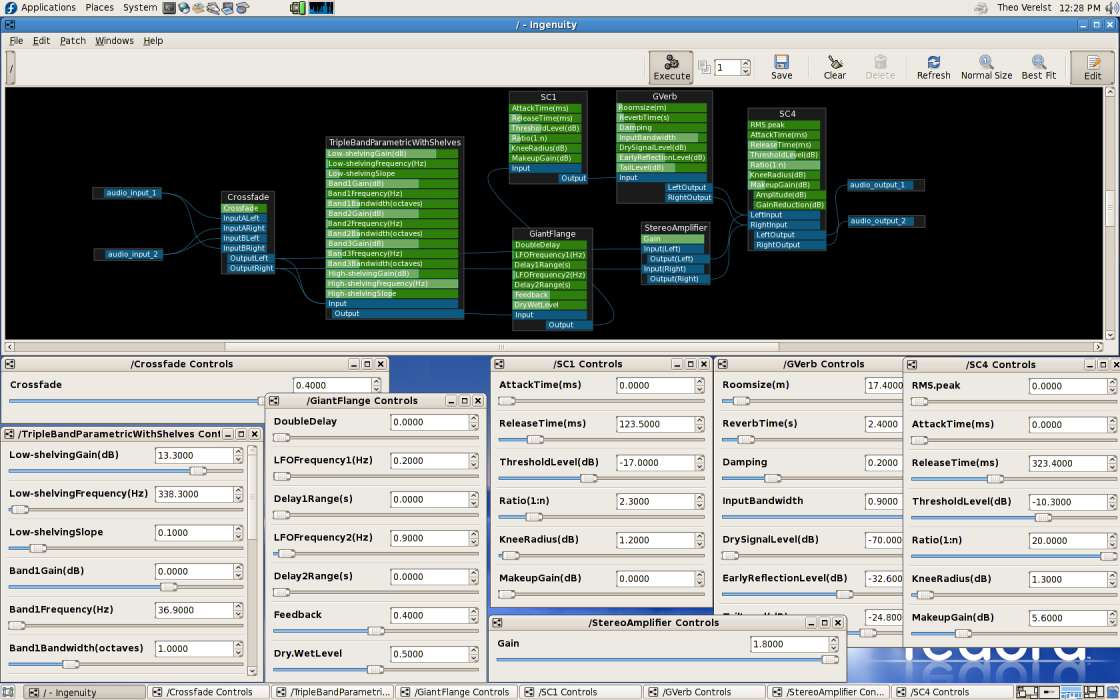
Screen
3 with Ingenuity showing the processing blocks, connections, and
parameter settings
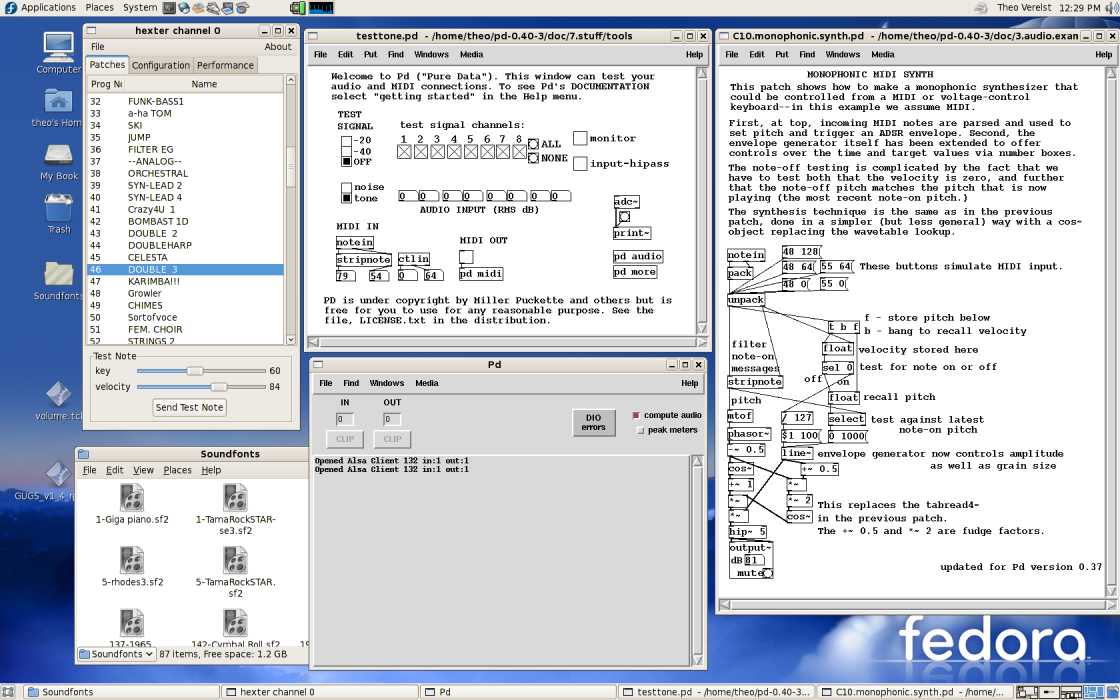
Screen
4 with the synthesizers Hexter (Dx7 like) and PureData (blockwise
synthesis)
I made some example music with this setup, starting with a multitrack
recording with rosegarden of some hexter sounds with ingenuity
processing, and then combined like above with a combined hexter/PD
sound with ingenuity coupled LADSPA effects, which is then input to
rosegarden, and recorded on a new track. The audio file (32 bit
floating point x2 stereo) I compressed with ffmpeg to mpeg audio file
which you may download and listen to:
example 1
strong combined hexter sounds
example 2
exa 1 with additonal PureData analog synth sound
example 3 idem
Mike Stern Bootleg
Not really its just an extremely short impression shot of the concert
he gave at North Sea Jazz this year, which however was a good one. And
it is in High
Definition ! So all people who want to try may sent the server
traffic peaking skyhigh. Well , we´ll see it´s got about a
megabit per second upload capacity and the machine can handle that
while dozing.
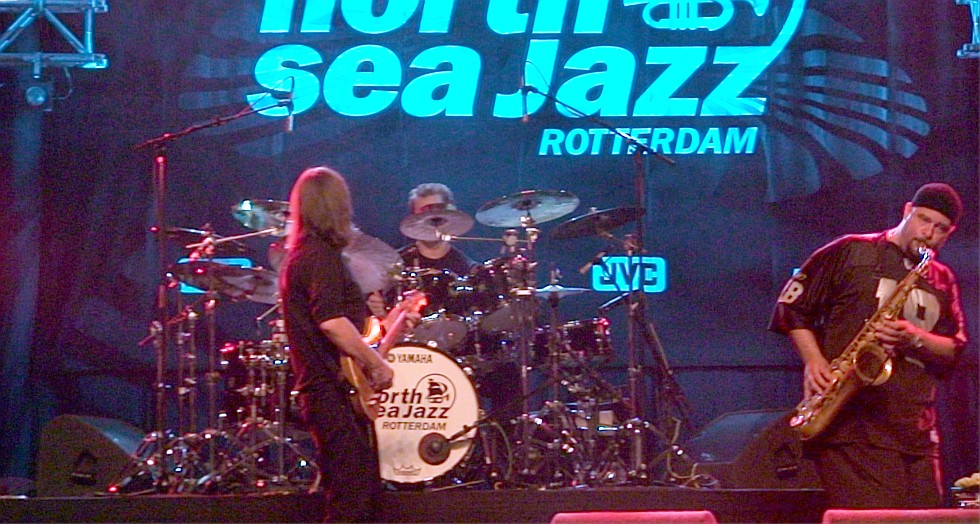
And its a beautyfull shot in fact, even though it isn´t without
motion at all (meaning its wobbly), here are various files for
downloading of the same 35 seconds fragment (the cam and record light
were
visible in the audience, and I recoreded only this little piece in
1080i, at 25megabit/sec):
nsstern_720_3k.mpg
3.5 kilobits per second mpeg-2 video and mp3 audio (48kHz 256kb/s
stereo) transport stream
the video is 720p aspect ratio 16:9, frame rate 25 frames/sec. (15.0
MegaByte)
nsstern_720_8k.mpg
8 kilobits per second mpeg-2 video and mp3 audio (256kb/s) transport
stream
the video is 720p aspect ratio 16:9, frame rate 25 frames/sec. (37.7
Mbyte)
nsstern_8m.mpg
8 kilobits per second mpeg-2 video and mp3 audio (256kb/s) transport
stream
the video is 1080i aspect ratio 16:9, frame rate 25 frames/sec. (37.8
MByte)
On 512 kilobit Adsl the download of the first version should take 4
minutes, preferably use right-click ´Save As´ on the link
and save to disk and then double click or what you have. Every person
with more then 1024 Adsl or equivalent should normally count on 2
minutes download time (about four times too slow for realtime playing).
Play it with any mpeg video player, but you´ll need a big enough
screen (1280x720 pixels or more) and a pretty fast computer to keep up
with decoding this material properly (which means including the
jerkyness...). For the full effect probably the middle file is best to
download, and then use a 1920x1080 or bigger screen to show the film
fragment, probably you´ll need hardware acceleration to keep up
with this size (I use NVidia´s PureVideo on a Quadro card with a
1920x1200 pixel good quality screen which is excellent). Because the
original is in 1080, the information in the 720 file can be used to get
an impression of the original resolution, and then the result
isn´t bad at all, given such a low bitrate. For comparison, the
last file is also 8 kilobit per second, but it is encoded at full 1080
(i) resolution. The original is 1080i at 25 Mbit/s which is a major
difference and looks of course better still. The downscaling has been
done by first saving the right fragment from Cinelerra in H264 format
with the quantisation error set to 1 which makes for a file a lot
bigger then the ingoing 25Mb/s original firewire based mpeg2 transport
stream from the camera. H264 does a lot of signal analysis and is a
good format to derive the downscaling to 720 from, which I´ve
done with ffmpeg, like so (on Fedora 7 64 bit):
ffmpeg -aspect 16:9
-i Tmp/nsstern.mpg -b 3000k -ab 256k -f mpegts -s 960x720 -aspect 16:9
-title "Mike Stern at Northsea Jazz 2007" Tmp/nsstern_720_3k.mpg
That´s the famous Dave Weckl on drums and Bob Francescini on
saxophone. Let me know if you can play the files !
At the same day (and site of course) I saw Chick Corea, for extra
money, and I think he was angry...
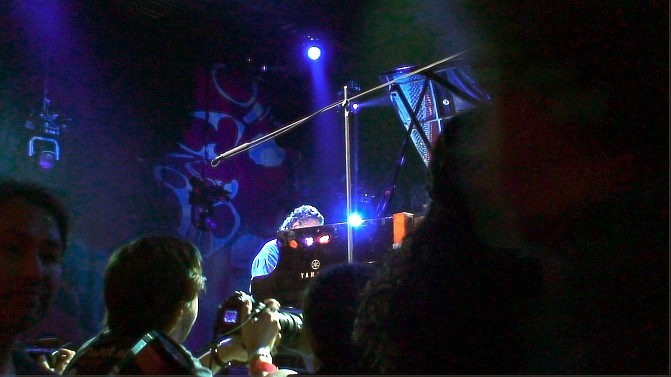
That´s him, behind the grand.
Any new mastering tricks comping up?
Well, I don´t really believe in all that mastering and such, I
mean the terminology isn´t really appealing to me. Maybe
that´s easy for me to say, I´m official "master of science"
in the highest engineering branch there was / is (EE) so maybe I
shouldn´t say that. On the other hand I started the study before
that was the case, I would become University Engineer, that appealed to
me, not the title lawyers get, too..
But audio mastering is fine of course, it means something like adapting
a song which is mixed to a certain medium and audience like CDs for
consumer use.
The thing still up my sleeve makes the experience of setting the high
quality audio system to the right volume and source more professional
and appealing: the high quality analog mixer and volume control unit,
which has an ethernet connection for computer driving.
It takes the output from the Lexicon DA converter, and adjusts the
volume. Boring, you say ? Not alltogether, because it is not trivial to
do so. You may say ´I can buy a digital mixer with midi for
little money´. True to some extend, but seriously, I meant High
Quality. If you´ve used digital mixers in practice, even decent
ones, you know that
The stars in the telescope
I got access to a cheap but serious Meade telescope while away to a
northern province in holland where I used to go sailing as teenager and
later on. Nice to look up under an unpolluted piece of the sky in the
countryside. I didn't have a compass so as it was, the automatic
positioning system couldn´t be set up to point the right way so
that two reference stars would calibrate the direction and altitude of
the telescope. I had one star sky program with me, which came with the
telescope, but I didn´t have a fully clear sky, and failed to
orient right (for instance to the polar star) so I couldn´t
figure out the course direction of north. When I got a compass, the sky
was cloudy :(.
It was however great to be in the countryside, many kilometers away
from sities or even big villages, and gaze at the sky with
magnification. I tried out making pictures and even HD (!) video
through the telescope, and that appears to be quite possible at not too
high magnification, though setting it up is not easy. I think I ended
up using the upper (inverted, prisma mirrored) ocular outlet on the
traditional telescope body, and put the camera above a single barlow
lense, without the oculair, and then focussed somehow in the macro
range of the camera... The result was I could look at treetops very far
away with not too bad result at all, and of course all kinds of
interesting light effects because of the advanced HD camera image
processing and CMOS clearvid sensor optimisations.

Both the telescope and the camera have to be up to good and realistic
images to get good results of course. Maybe it is't all true that
equipment in a chain is limited to get bad results if there is one weak
link in the chain, but usually it is hard to compensate for the
lack of correctness of one of the links in a chain of processing, and
in various cases impossible: when the requires information doesn't get
through the problem link, or when the error introduced by the problem
link cannot be corrected, for instance because inverting it has no
single solution.
The camera has a ´slow coulour shutter´ which I appreciate
(also night vision, but that is mostly black and white and preferably
uses a infrared light source, which his hardly practical to aim at the
stars...) the following photo is made with that setting but now the
telescope was pointed somewhere at the night sky. Anyone care to tell
where, I honestly tried myself, probably the altitude is in the range
of Cygnus and about 30 degrees too much east but I don´t have any
idea what the bright stars are!
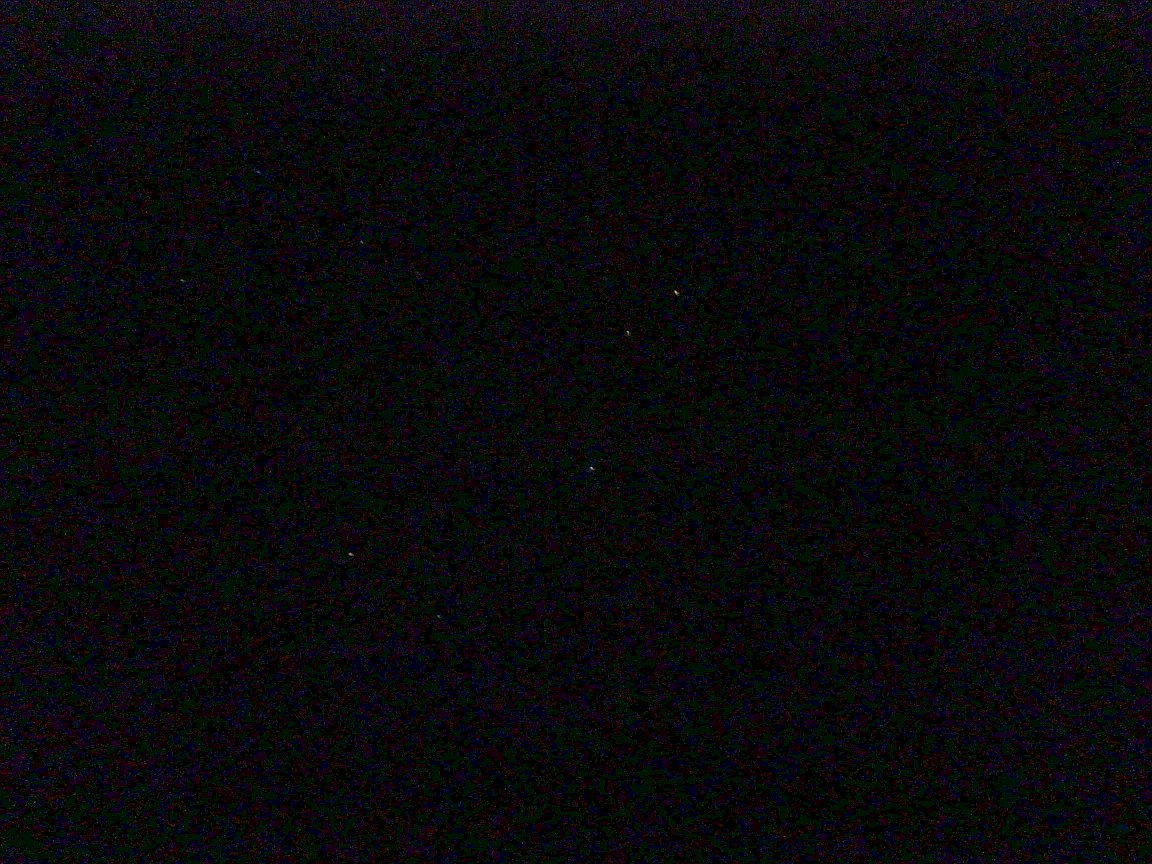
To make the image more clear on a notebook in daylight I inverted the
image:

the original is in HD (2k) format.
Later I found out also in Amsterdam city area it is possible to see
stars at least (though the weaker milky way and nebulas and such
I don´t think) so I made a short HD recording of the moon through
the telescope, but I held the camera by hand. The result is wobbly and
I was trying to focus right and get the whole little round image spot
of the telescope to fill the picture area of the camera, and then
pieces of the moon edges would disappear, but it is still a pretty
image, and the film does look great on the beamer (in 720 HD) because
there is something magic about the light from the moon, and at a
diameter of about a meter and a half, that is very clear!
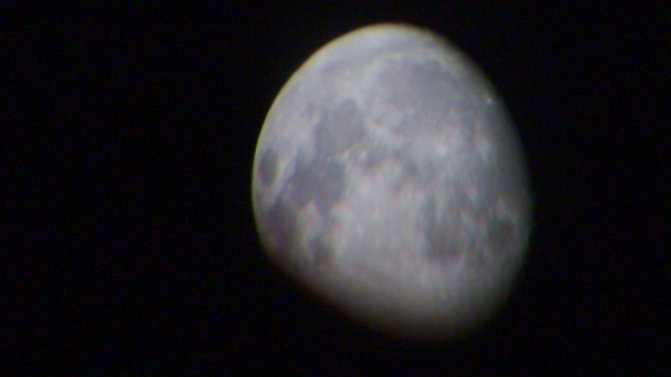
I consider attaching the cam to the telescope with some mechanical
constuction so that it can turn with the telescope in follow mode (so
that it stays aimed at the moon while it moves) so the picture becomes
stable, and then using a notebook with firewire and network connection
to transfer the live HD image over 30 meters of ethernet and then 10
meters of DVI cable to the beamer, which would be cool. and than next
to that use this window with stellarium´s sky at a certain time:
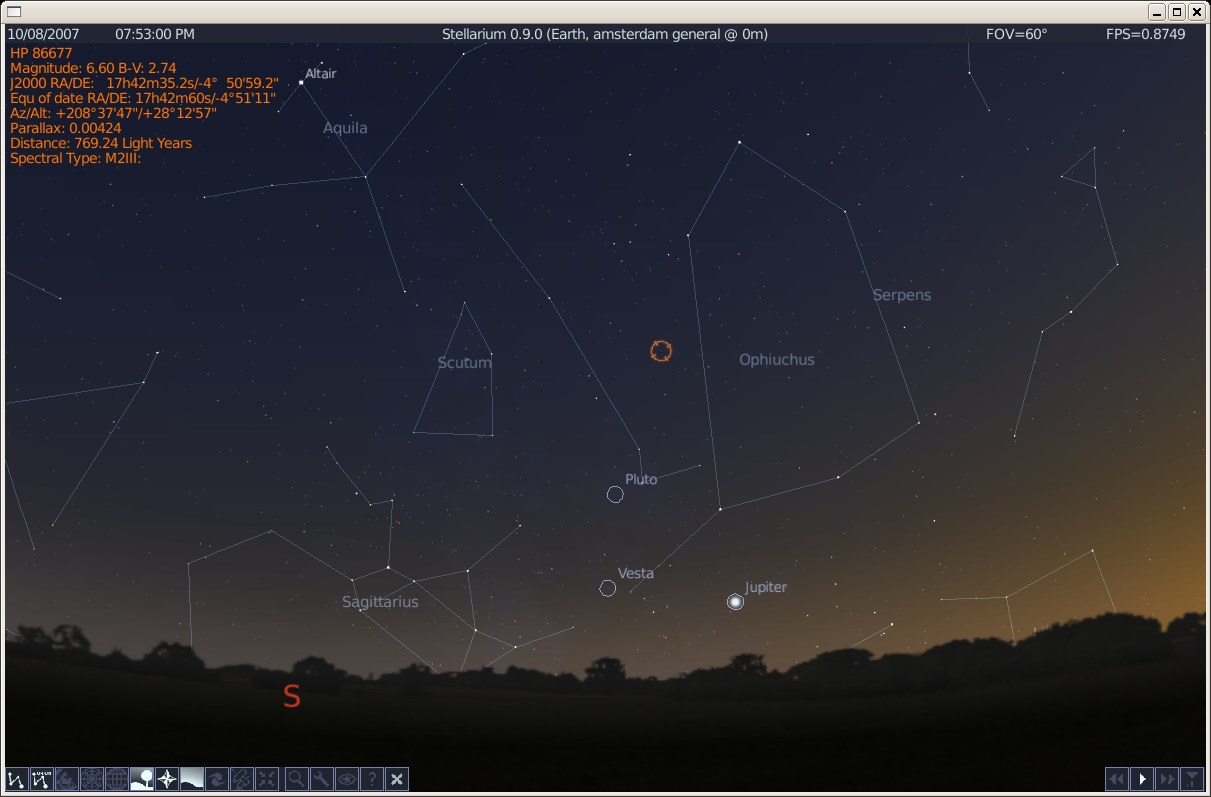
and then even more cool make the telescope connected over it´s
serial connection to browse the real sky in real time with beamer
telescope view! That hasn´t been realized yet.
This time around I recorded the HD moon take, firewired it using linux
to a disc, and transfered it over the ethernet to the server, from
which it can then be taken to view, and transfer time is about 3 times
the required live speed of 25 megabit per second, as can be seen here:
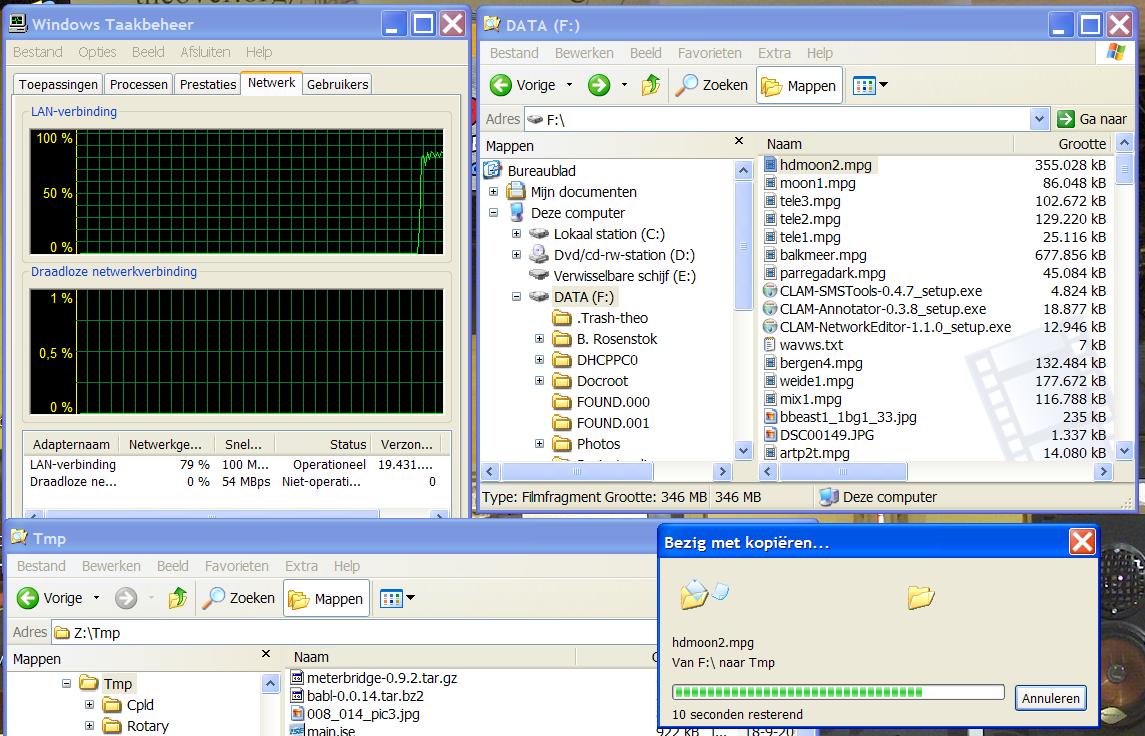
works usable (z: is the server you read this page from).
Pro Pictures
Well, why not, I´ve been paid for pictures before, but for a long
time already this is hobby, but of course I can do pro quality, and of
course I´m first of all then working on making my HD recording
skills work real good. That is not easy, as most people who have tried
will know that even recording standard definition video at acceptable
level of quality is certainly not easy.
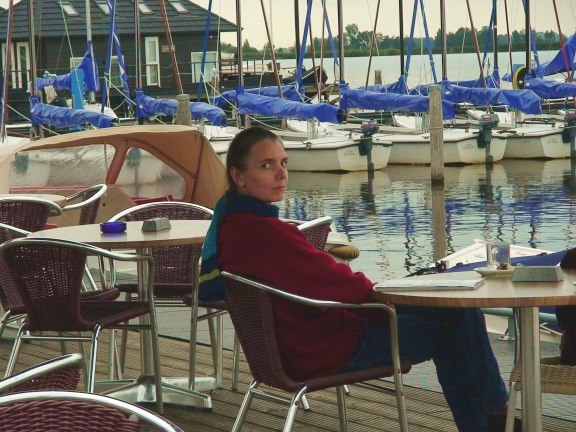
But it is fun to try making good looking material, and then thinking
that professional means to say it right what it is and what it
isn´t. Pretty pictures belong there, but with a good standard of
thinking, not just ot esteblish another stylisation which gets a
certain drawer assigned in the New System.
